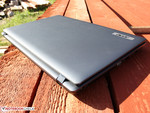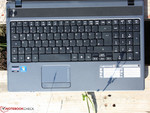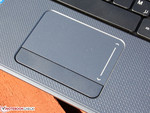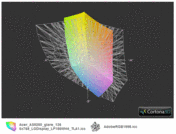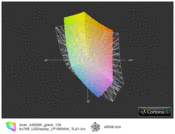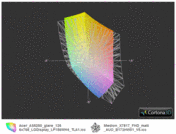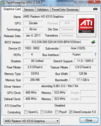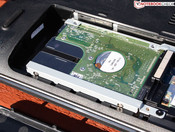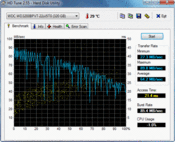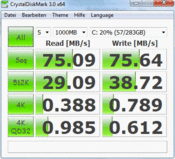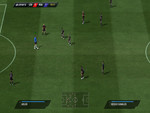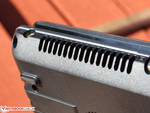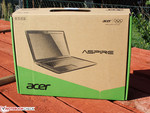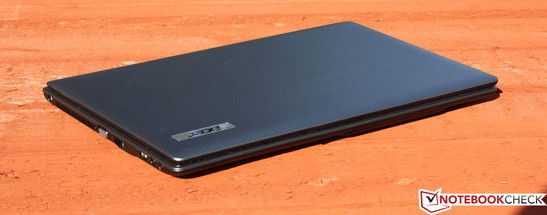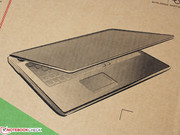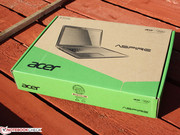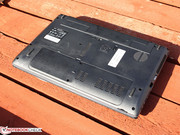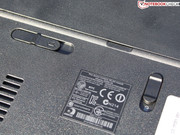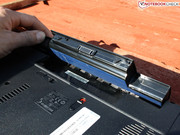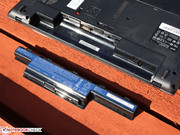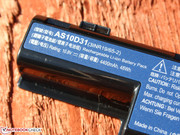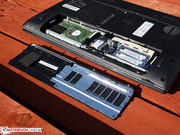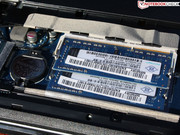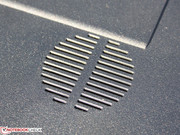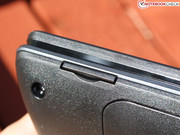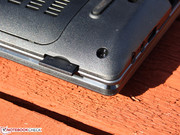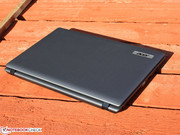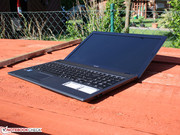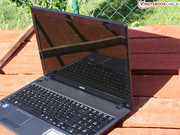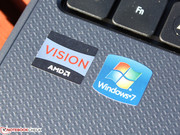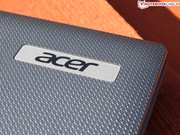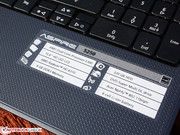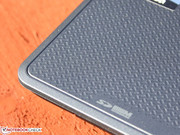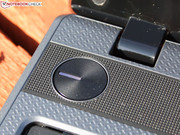Review Acer Aspire 5250-E304G50Mnkk Notebook

In March 2011, we tested the Acer Aspire 5253. This system featured the then brand new AMD Fusion platform, the AMD E-350 (2 x 1.6 GHz). AMD later released the E-450, a fairly minor update to the E-series, which didn't really have any impact on performance and features.
This time around, Acer installs a new E-series processor into a chassis that remains 95% unchanged from the last model. Not a very exciting prospect, since the new CPU E-300 has a lower core frequency (2 x 1.30GHz) and uses the same GPU as the E-350/450 (Radeon HD 6310). Why a downgrade? Do we really need a "new" CPU that is slower than the models from over a year ago? We can at least hope that the lower core frequency will allow for longer battery life.
Case
We had to look very hard to find any differences to its predecessor, the Aspire 5253. The Acer logo, which was comprised of single letters in the middle of the lid, is now embedded as a label in a corner. The old model had status LEDs for the HDD and the WLAN next to the power button. These status lights were completely eliminated on the new laptop. Guess we have to listen to the hard drive to figure out if the system is busy or not.
The chassis is now less rigid. It's easy to twist the base unit and the display lid. At least the lid is sufficiently solid. We like the feel of the textured matte surfaces which resist smudges and finger prints very well.
The hinges hold the display well without allowing it to rock back and forth. They are a bit tight though, so both hands are needed to open the display. The maximum angle of 160º is more than adequate while using the notebook on the lap.
The photos show the port selection to be pretty meager. There is an empty spot where the previous model had an HDMI port. The number of USB ports hasn't been increased though, with only three. Reason for the missing HDMI port might be pointed to the manufacturer who had to pay a license fee when integrating such a port. The position of the USB ports on the left and right side is not the best, as cables plugged into them and the VGA port can interfere when using a mouse. At the very least, having the cables stick out looks untidy.
Communication
Internet connections are available via Ethernet and WLAN. Both modules are the same ones found in the Aspire 5253. The Atheros AR5B97 WLAN card lost the Bluetooth 3.0 module. The Atheros AR8151 Ethernet Adapter supports Gigabit-Ethernet.
Accessories
There are no recovery discs included in the box - a common trend we've seen for a few years now. The user has to create his/her own recovery disc set using the Acer Recovery Manager. The number of pre-installed software titles is fortunately not too overwhelming. Acer GameZone, Accessory Shop, Registration, Updater, and Office 2010 Starter are of course part of the package. The biggest pre-installed program is NTI Media Maker 9 which is used to convert video files and to burn optical discs. The inclusion of said software is actually not very generous on Acer's part, since Media Maker 9 can be downloaded for free.
Warranty
It is a rarity to have 2 years warranty which includes pickup and return service that allows the sending of the laptop to Acer for repairs free of charge. Until recently, Acer's low-cost models only came with 12 months of pickup and return service.
Input Devices
Keyboard
Key travel is ample but the keys lack distinct feedback. The keyboard flexes near the Enter-key. Because of the spongy tactile feedback, we didn't enjoy typing very much. The arrow keys are half-sized but at least they are separated from the Shift-key, which makes touch typing a lot easier. The traditional layout takes full advantage of the width the 15.6-inch laptop offers and is therefore suitable for large hands.
Touchpad
The touchpad is from Synaptics (V7.2). The surface is smooth and cursor control is both fluid and accurate. It features a marked vertical scroll bar; the horizontal scroll bar is unmarked but can be activated if desired.
The mouse buttons make a hollow sound but remain quiet. Actuating a click is easy although the travel is short on the sides and even more limited towards the middle. Overall feedback of the buttons is lacking. Even though the touchpad is responsive up to the edges, we felt it was a bit cumbersome to use. A perfect office touchpad would have buttons that offer more travel; in addition, it would not be recessed as deeply.
Display
Acer has been using the featured panel (LP156WH2-TLEA) for over a year now. This glossy display (with a native resolution of 1366 x 768 pixels) was also used in the older Aspire 5253 and features low contrast and just about average brightness. Our measurements (see below) are pretty standard fare for office-type notebooks. Higher end panels are usually not available in the price bracket below EUR 500 (~$610). This is different for tablets where even middle-class models starting at EUR 300 (~$370) feature better panels (IPS: better viewing angles, higher contrast).
The low contrast ratio of 136:1 comes as no surprise. Although glare-type displays tend to make colors look better, the measurements reveal the truth about the quality. Those wanting to use this laptop as only a typing device would probably prefer a non-glare screen. The notebook is pretty much unsuitable for any professional application since it can't accurately reproduce any of the color spectra. Our comparison has the display up against AdobeRGB (t), sRGB (t), and the Medion Erazer X7817 (equipped with a good consumer TFT).
| |||||||||||||||||||||||||
Brightness Distribution: 92 %
Center on Battery: 207 cd/m²
Contrast: 136:1 (Black: 1.52 cd/m²)52.2% AdobeRGB 1998 (Argyll 2.2.0 3D)
70.6% sRGB (Argyll 2.2.0 3D)
54.2% Display P3 (Argyll 2.2.0 3D)
Brightness distribution is very even at 92%. The LED backlight manages to keep the illumination very constant. We couldn't find any light or dark spots on the screen. The average display brightness is decent at 200 cd/m².
The display of the 5253 is all but unusable outdoors. The brightness level is sufficient for the office and in theory for outside usage, as long as it's cloudy or the laptop is used in the shade. Distracting reflections are a common issue with glare-type displays.
Two or more people would not be very happy with the Aspire 5250 should they attempt to view the screen at same time. At least that's what our comparison of different viewing angles shows, which consists of nine photographs taken in a dark room.
Horizontally, the panel can be viewed at an angle of up to 45º; any more than that and the screen starts to darken and colors invert. Vertical angles are a lot more restricted, as the already mentioned effects start to appear at an angle of around 15º.
Performance
Acer equips this 15.6-inch notebook with the dual-core APU AMD E-300 (2 x 1.3 GHz). This particular processor is in the same family as the E-450, which is used in some versions of the Aspire 5250. The APU (Accelerated Processing Unit) has a TDP of a miserly 18W and is particularly well-suited for small notebooks. The Integrated Graphics Unit, a Radeon HD 6310, has DirectX-11 support and a UVD3 Video Decoder. It is marginally slower than the HD 6320 in the APU E-450. The APU has access to 2 x 2048 MB of DDR3 RAM. The hard disc drive is a Western Digital (WD3200BPVT-22JJ5T0) with 320GB storage space. The OS supplied is Microsoft Window 7 Home Premium (64 Bit).
Processor
Looking at the scores of the E-300, we can only come to one conclusion: this processor ranks at the bottom of the pile. It almost seems ludicrous to pair up a CPU offering basically netbook-like performance with a 15.6-inch laptop when Intel's low-cost Pentiums offer so much more performance. There has to be demand, however, since there is even a 17-inch notebook with the APU E-450 (Packard Bell EasyNote LK11-BZ-080GE).
Subjected to Cinebench R11.5, the E-300 was only able to reach 0.46 points. Other processors, like the Pentium P6100 (+185%), Core i3-350M (+224%), i3-2310M (+340%), or the AMD A4-3300 (+146%) are substantially faster. The only CPU that manages to be even slower is the netbook processor Atom N450 (-43%). CPU performance remains the same whether the laptop is on battery power or on external power. Other notebooks with the same performance are the Aspire One 722-C62kk (C-60) and the ThinkPad X121e NWS62GE (both have 11.6-inch screens).
System Performance
More important than the processor benchmark is the evaluation of overall system performance. Our test system reached a score of 834 points after we ran PCMark 7 on it. This test takes the speed of the HDD, RAM, and the graphics card into consideration. The HP 630-LH384EA with a Pentium CPU managed to be only about 36% faster here - courtesy of the rather weak Intel GMA IGP. AMD-based A6-systems are, depending on the clock speed and the GPU, 75% to 100% faster. Towards the top we find the Core i3-2350M (+90%). A better GPU can improve performance further like in the Sony Vaio SV-E14A1M6EW, with the Radeon HD7670M (+120%). An Atom (N2800) based netbook, like the Asus Eee PC R052C-WHI002S, is only about 11% slower, despite the weaker GMA 3650.
| PCMark Vantage Result | 1807 points | |
| PCMark 7 Score | 834 points | |
Help | ||
Storage Devices
HD Tune showed a sequential read speed of 64 MB/s for the 320GB Western Digital HDD. Small and dispersed data reads cause the fairly slow read-write heads to lag behind and the speed drops to 0.4 to 1.0 MB/s. 7200 rpm models do better here. Notebooks with SSDs are significantly faster, as even the slowest ones start at around 120 MB/s and go up to about 376 MB/s. The hard drive in the Aspire 5250 ended up with a below average HDD score of 2296 points in PCMark Vantage. SSD equipped laptops manage 300% to 2800% better results here.
Graphics Card
In 3DMark2006, our test system scored 1943 points. This result means that the Radeon HD 6310 has 24% less performance than the HD 6320 in the E-450. Of course the 6310 can't compete with any (even low-end) dedicated GPUs like the GT 630M (+312%) or the Radeon HD 7610M (+221%). Intel's HD3000 was 30% to 150% faster; the current HD4000 tops these results.
The three game tests that follow show extremely low FPS values even with older games. Playing games should not be on the agenda, period. The main purpose of the Radeon graphics is to relieve the weak APU of HD-decoding duties. This decoding doesn't just happen in the conversion tools like Media Espresso or the (pre-installed) NTI Media Maker 9, but even when using the Media Player.
Acer's clear.fi player manages to play 1080p clips with CPU utilization below 20% CPU. We were able to start another movie clip in Media Player (CPU <45%) without encountering any stuttering. We recommend not starting too many programs, since the mouse pointer is apt to show significant lag and installations will take forever.
| 3DMark 06 Standard Score | 1943 points | |
| 3DMark Vantage P Result | 662 points | |
Help | ||
| low | med. | high | ultra | |
| World in Conflict - Benchmark (2007) | 31 | 8 | ||
| Far Cry 2 (2008) | 18.8 | 10.1 | ||
| Fifa 11 (2010) | 46 |
System Noise
Overall noise level is pleasant. The fan never turns off but doesn't exceed 31dB (A) during idle. During activities like surfing, listening to music, or typing, the fan noise stays constant and discreet in the background. Since the range between idle and load is very small, we could only measure an rpm difference but not hear it. The HDD is now less audible during read/write access than the one in the Aspire 5253. While the HDD in the predecessor emitted a high-pitched hum of 33.9dB (A), the new HDD remains under the noise level of the system fan.
The game tests we conducted didn't push the cooling system much either, as the noise level remained at 31.9dB (A). Even during the stress test (Furmark & Prime95), we only measured a maximum of 32.9dB (A). As before, the rpm remained constant. Overall the fan control is very well executed. Acer decided to let the fan spin constantly during idle to avoid having it turn on and off all the time.
Noise Level
| Idle |
| 30.9 / 31 / 31.1 dB(A) |
| HDD |
| 30.9 dB(A) |
| DVD |
| 35.4 / dB(A) |
| Load |
| 31.9 / 32.9 dB(A) |
 | ||
30 dB silent 40 dB(A) audible 50 dB(A) loud |
||
min: | ||
Temperature
We measured an average of only 30ºC (86ºF) at the bottom of the notebook during word processing tasks and surfing the Internet (lots of idle time). The palm rest tops out at 27-30ºC (80.6 - 86ºF). The temperatures are slightly higher than the ones we recorded for its predecessor, but we also conducted the tests at a room temperature of 23ºC instead of 19ºC (73.4ºF instead of 66.2ºF). We can assume that temperatures would have been a bit lower otherwise. Under load, we measured up to 46ºC (114.8ºF) on the bottom. At this temperature, having the machine sitting on the lap is pretty uncomfortable. The APU does not have any sort of turbo mode, so throttling is not an issue. Cinebench R11.5 Multi showed that the cores of the E-300 remain at 1.3 GHz at all times.
(±) The maximum temperature on the upper side is 43.6 °C / 110 F, compared to the average of 34.2 °C / 94 F, ranging from 21.2 to 62.5 °C for the class Office.
(-) The bottom heats up to a maximum of 46.1 °C / 115 F, compared to the average of 36.7 °C / 98 F
(+) In idle usage, the average temperature for the upper side is 28.5 °C / 83 F, compared to the device average of 29.5 °C / 85 F.
(-) The palmrests and touchpad can get very hot to the touch with a maximum of 43.6 °C / 110.5 F.
(-) The average temperature of the palmrest area of similar devices was 27.7 °C / 81.9 F (-15.9 °C / -28.6 F).
Speakers
Two stereo speakers are located above the keyboard. The sound emphasizes higher frequencies while the middle and lower range are lacking. Bass is almost nonexistent. Turning up the volume all the way leads to distortions. At least there is a headphone jack to hook up headphones or external speakers.
Power Consumption
Does the low performance translate into equally low power requirements? With all energy-saving options enabled and the display brightness turned down all the way, idle power consumption is only 7.6W (Aspire 5253: 9.7W). A more realistic scenario is the maximum idle power consumption of 12.6W. All things considered, the Aspire 5250 is not that energy efficient. Even a well-equipped multimedia notebook like the Samsung 550P5C-T02DE with an i5-3210M and GeForce GT630M, only requires 8.3/11W (minimum/maximum) during idle (5250: 9.7 to 13.6W).
During 3DMarks 2006, power consumption rose to 26W. Maximum power requirement during the stress test (Prime95 & Furmark) was 28W. The power adapter is rated for 65W and hence more than adequately sized.
| Off / Standby | |
| Idle | |
| Load |
|
Battery Life
The AMD Fusion system with the longest run time (WLAN-test) is the Samsung 305U1A-A01DE. This 11.6-inch system lasted for almost 9 hours. The HP Pavilion dm1-3180eg kept running for about 7 hours, while the Lenovo ThinkPad X121e NWS5QGE lasted for about 5 hours (both are 11.6-inch systems). Our test system lags a bit behind with only 4 hours. The older Aspire 5253 managed almost 5 hours in the same test.
The 48Wh battery can't be the culprit because the Aspire 5253 came with a battery offering the same exact capacity. It takes 1 hour 35 minutes to recharge a completely depleted battery. When we were playing a DVD movie, the laptop ran out of charge after 3 hours 25 minutes.
Verdict
Is the never-ending supply of new notebooks offering more features and better performance just too confusing? Acer tries a different approach and downgrades the already low-cost Aspire 5253. Who needs HDMI, after all?
The Aspire 5250 is a notebook on a feature diet. The fact that the CPU (E-300) is even less powerful is something we could overlook, since the E-450 model (2 x 1.65) is also available. But trying to cut features (no HDMI) on what was a low-end model to begin with - that's almost audacious.
The price difference is only a few euros. Those who don't care much if they pay EUR 369 or EUR 374 should opt for the E-450. The sister model featuring the E-350 also had a longer battery life on our test.
We honestly can't recommend the Aspire 5250. The Asus Pro P53E-SO136D, X54C and the Lenovo B570 (no OS) are systems in the EUR 375 to EUR 400 price bracket featuring the Core i3-2350. For about EUR 300 you can get yourself a Pentium-equipped TravelMate 5742Z (with Linux OS). Even though that system features obsolete hardware, it offers faster performance and probably about the same battery life.
AMD's E2-1800 (2 x 1.70GHz) with Radeon HD 7340M is truly new. Stay tuned for reviews of the HP 655 (starting at EUR 330) and the Lenovo G585.


 Deutsch
Deutsch English
English Español
Español Français
Français Italiano
Italiano Nederlands
Nederlands Polski
Polski Português
Português Русский
Русский Türkçe
Türkçe Svenska
Svenska Chinese
Chinese Magyar
Magyar